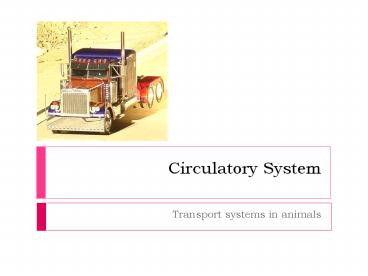Circulatory System PowerPoint PPT Presentation
Title: Circulatory System
1
Circulatory System
- Transport systems in animals
2
Overview
- Reptiles
- Birds
- Mammals
- Functions of a transport/circulatory system
- Cellular transport
- Invertebrate circulation
- Gastrovascular cavity
- Water vascular system
- Open circulatory system
- Closed circulatory system
- Vertebrate circulation
- Fishes
- Amphibians
3
Functions of the circulatory system
- Transports materials
- Nutrients from digested food
- Respiratory gases CO2 and O2
- Waste materials toxins and nitrogenous wastes
- Antibodies
- Hormones
- Enzymes
- Immune functions
- Maintains homeostasis
- Blood pH
- Heat transport
4
Transport at the cellular level
- Cell membrane
- Passive transport (diffusion, facilitated
diffusion, osmosis) - high concentration of solutes to low
concentration of solutes - no need to expend energy
- Active transport
- spending energy
- moving materials from low concentration to high
concentration of solutes - Transport of large molecules
- endocytosis ? vesicles ? exocytosis
- Cyclosis (cytoplasmic streaming)
- occurs in eukaryotes, e.g. Paramecium
- facilitated by microfilaments
- requires energy
5
Transport at the cellular level (cont)
- Endoplasmic reticulum
- manufacturing and transport facility
- proteins produced in rough ER are packaged in
vesicles - Golgi apparatus
- modification and storage facility
- receiving end and shipping end
- Vacuole
- large membrane bound sacs
- usually stores undigested nutrients
6
How are materials transported in multicellular
organisms?
- Gastrovascular cavity in simple invertebrates
- No system is required
- Single opening exchange of materials with the
environment - Central cavity for digestion and distribution of
substances throughout the body - Body walls are two cell layers thick ? materials
undergo diffusion - Cnidarians (e.g. Hydra) and flatworms (e.g.
planarians)
7
How are materials transported in multicellular
organisms?
- Water vascular system in echinoderms
- multi-purpose locomotion, food and waste
transport, respiration - closed system of canals connecting tube feet
- madreporite ? ring canal ? radial and lateral
canal ? tube feet ? ampullae
8
How are materials transported in multicellular
organisms?
- Open circulatory system
- Phylum Arthropoda, Phylum Mollusca (with one
exception) - hemolymph (colorless)
- heart(s) ? sinuses ? ostia ? heart(s)
- diffusion from sinuses to organs
- insects well-developed respiratory systems, O2
not transported through the blood
9
How are materials transported in multicellular
organisms?
- Closed circulatory system or cardiovascular
system - cephalopods, annelids, vertebrates
- presence of blood vessels
- advantages
- rapid flow
- may direct blood to specific tissues
- blood cells and large molecules remain within
vessels - can support higher levels of metabolic activity
10
General plan of the cardiovascular system
- Heart
- Atrium
- Ventricle
- Blood vessels
- Arteries
- Arterioles
- Capillaries and capillary beds
- Venules
- Veins
- Blood
11
Different adaptations of the cardiovascular
systems in vertebrates fishes
- Single-circulation
- Fish heart
- 2 chambered hearts
- atrium and ventricle
- vessel
- African lungfish heart
- 3-chambered
- 2 atria
- left side of atrium receives oxygenated blood (to
tissues) - right side receives deoxygenated blood (to lung
or gills) - spiral fold
- partially divided ventricle
12
Different adaptations of the cardiovascular
systems in vertebrates amphibians
- Pulmocutaneous and systemic circulation are
partly separated - Amphibian heart
- 1 ventricle pumps blood to lungs, skin, and
tissues - 2 atria
- rt. atrium receives deoxygenated blood
- lt. atrium receives oxygenated blood
- advantage oxygen-rich blood reaches the bodys
organs faster - some mixing of O2-rich and poor blood occurs
13
Different adaptations of the cardiovascular
systems in vertebrates reptiles
- Reptilian heart
- 3-chambers (except for crocodilians with 4)
- 2 atria
- 1 ventricle (2 ventricles in crocodiles and
alligators) - partially divided, decreases mixing
- may stop sending blood to lungs when not
breathing
14
Different adaptations of the cardiovascular
systems in vertebrates birds and mammals
- 4 chambered heart
- 2 atria
- 2 ventricles
- full separation of pulmonary and systemic
circuits - Advantages
- no mixing of oxygenated and deoxygenated blood
- gas exchange is maximized
- separation allows for pulmonary and systemic
circuits to operate at different pressures - Importance
- Endothermic ? high nutrient and O2 demands in
tissues - Numerous vessels ? great deal of resistance, so
requires high pressure
15
Blood flow in mammals
- R side of heart
- pulmonary circuit
- L side of heart
- systemic circuit
- one way valves
- atrioventricular valves
- semilunar valves
16
Blood flow in mammals
- right atrium receives O2-poor blood from superior
and inferior venae cavae - from right atrium into the right ventricle
through the tricuspid valve - pumped into the pulmonary artery through the
pulmonary semilunar valve to lungs - O2-rich blood from lungs is returned to the left
atrium via the pulmonary veins - enters the left ventricle via the mitral or
bicuspid valve - exits the left ventricle into the aorta via the
aortic semilunar valve - circulated to body tissues

